André Santana and I agreed to have a friendly exchange about the merits of the spider-marriage. In the previous entry, I made my argument for why Peter Parker should be single in the comics. Now it’s André’s turn to make the case for why it’s better for Peter and MJ to be married.
Once again, his sections are in yellow.
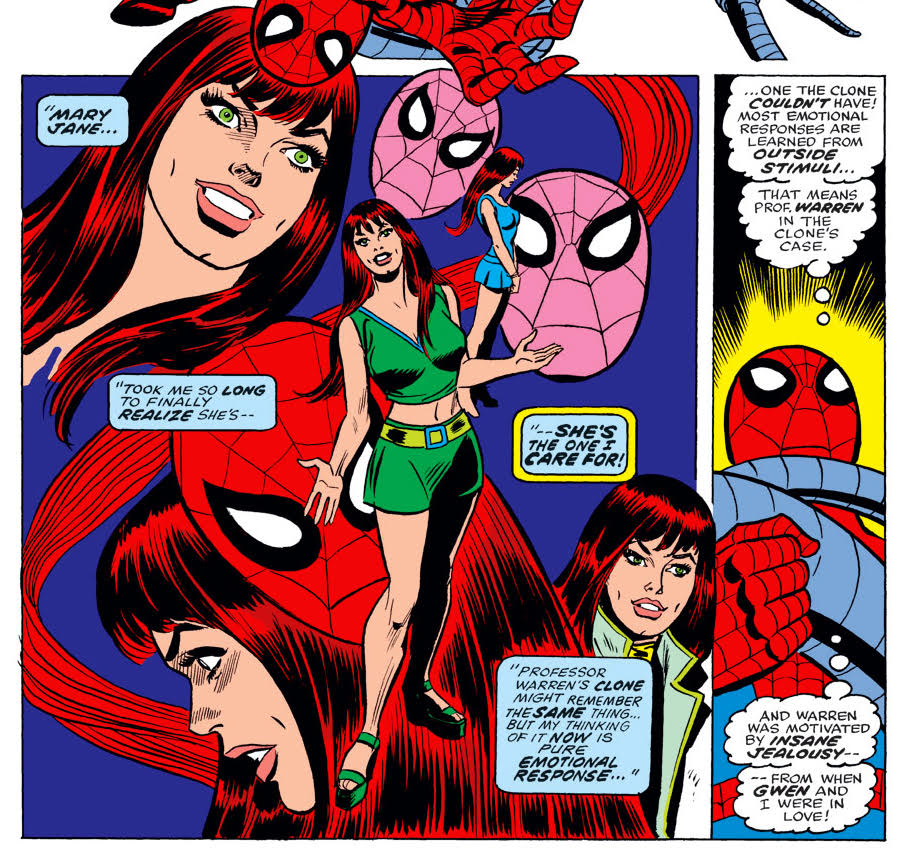
(Just bear with me for a minute)
- Unlike Batman for instance – whose personal life is not too much relevant to the non-reader -, and yet editors and writers try their hardest to insert and shove elements in his life to make him more “relatable” and more human since the early nineties (see the entire Bat Family), he could normally go on fighting crime and evil in their stories without their supporting characters; it’s doable. Of course, Alfred and Commissioner Gordon would require some appearances for the sake of the occasional talk to make the plot move along, but if you think about it, it’s perfectly doable, because it’s been done before. It´s Batman’s mold, per se. There’s no learning curve for character development because he doesn’t need one. We all know it.

- One of the reasons that DC’s The New 52! failed is that they tried to rewrite the past of each hero, thus taking all the supporting characters’ relations with the main one for granted. For Batman, they were kind enough to let Scott Snyder and Greg Capullo do their thing as if The New 52! Orwellian character rewriting effect had never happened. As for the others, especially Superman, it didn’t work: how could he ever be without Lois Lane after all those years? I’m talking about the progression of the characters’ lives once writers and editors realize that it’s time to move on since they regard and acknowledge these very superheroes as “humans”. Humans have conflict, drama, challenges, disagreements, challenges, interests, thoughts, emotions, and feelings. So of course, in order to make the verisimilitude factor a powerful tool to keep readers interested and invested in their monthly comic, those aforementioned elements have to be added because they are and behave like humans, despite their fictional existence. If the idea seems hard to grasp, just ponder on why there aren’t any steady monthly comics of the following characters: Vision, Martian Manhunter, Machine Man, Doctor Mid-Nite, etc.
The whole myth as to why Superman is a difficult character to write because he’s invincible is one of the most misconceptions ever created; all one needs to do is to write a tale in which Clark Kent needs to act as a failed human being, or at least pretending he’s one; the rest comes naturally. That’s why (and how) Jeph Loeb and Max Landis excelled in their tales for the Big Blue. They found humanity in him and dug really deep into the concept.
By the same token and on the opposite side, that’s what most writers fail about writing a good Spider-Man tale – too much superhero business that is forced into Peter Parker’s life. Things can (and should) happen in a natural fashion. It’s in the character’s DNA/Mold or instruction manual. And right there, there’s something that just can’t be undone, broken, or erased: his relationship with Mary Jane Watson. And with all that so far being said, we head to the next reason: - Dick Grayson, being the one “normal anomaly” in DC’s roster of heroes was the teenager who successfully grew up. I even dare suggest t the Nightwing creation came to be as a direct inspiration from Peter Parker. And Marv Wolfman (as his co-creator), had already a good and stable run on Spider-Man. So if Peter could grow up, evolve, mature – and be happy – why not Dick Grayson? On that note, J. Michael Straczynski showed exactly that from the beginning of his run in ASM, displaying how emotionally incomplete Peter Parker was without MJ until they got back together; he was happy. And never backed down an inch from being Spider-Man. The best Aunt May ever written.
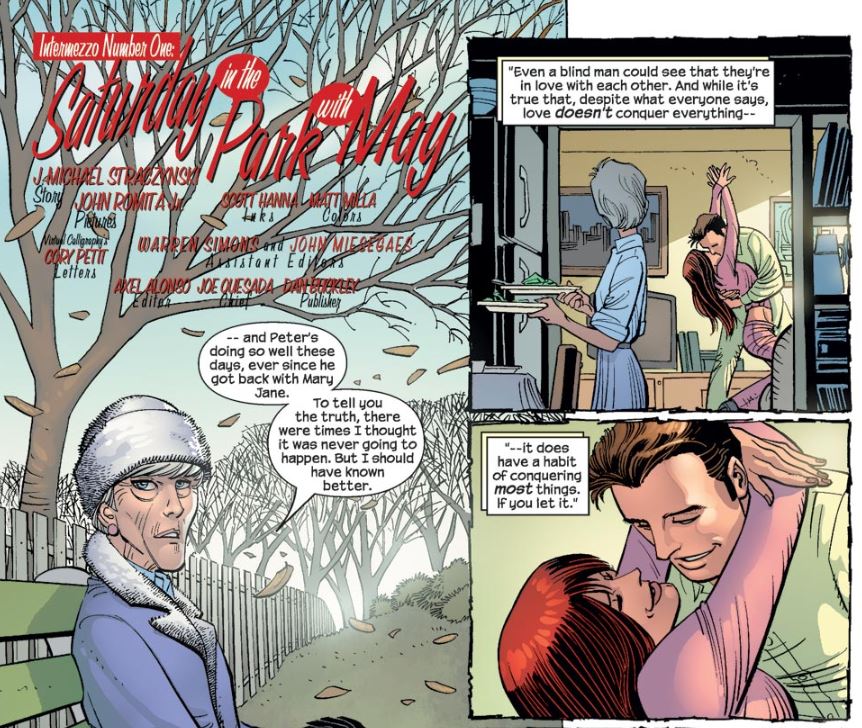
Putting all those reflections together, and considering how all the great writers who helped to build the Spider-Man mythos wrote great tales – thus inserting more drama and intensity into his life -, they realized that the once timid teenager Peter was inevitably becoming a man. This a rare exception in the status quo of superhero characters – mainly Marvel and DC’s. And since Spidey’s identity revolves around Peter’s life, anyone could assume that he would never quit being Peter Parker and living 24/7 as a superhero. He can’t; it’s right there in the first five hundred issues of The Amazing Spider-Man. And those issues built an irrevocable truth if we are to consider the verisimilitude of (our real) life in these fictional characters: Mary Jane Watson and Peter Parker are meant to be together.
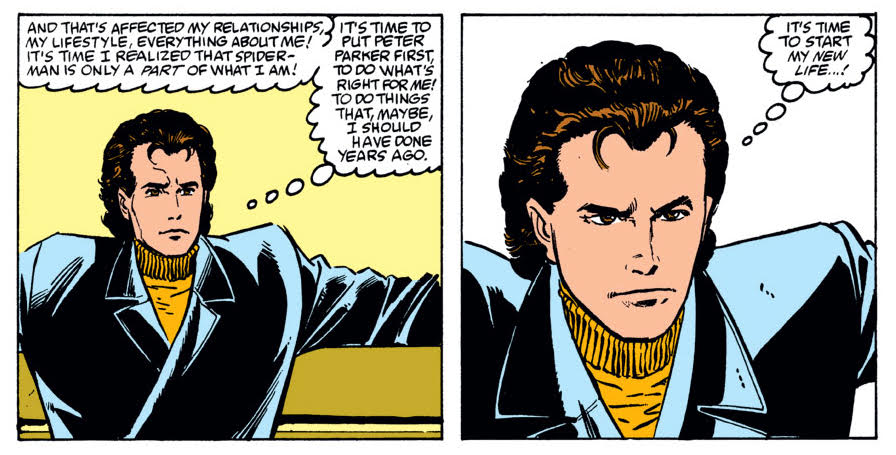
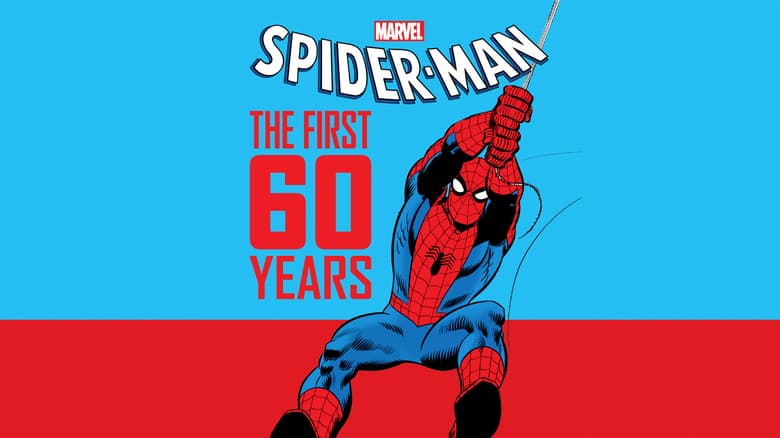
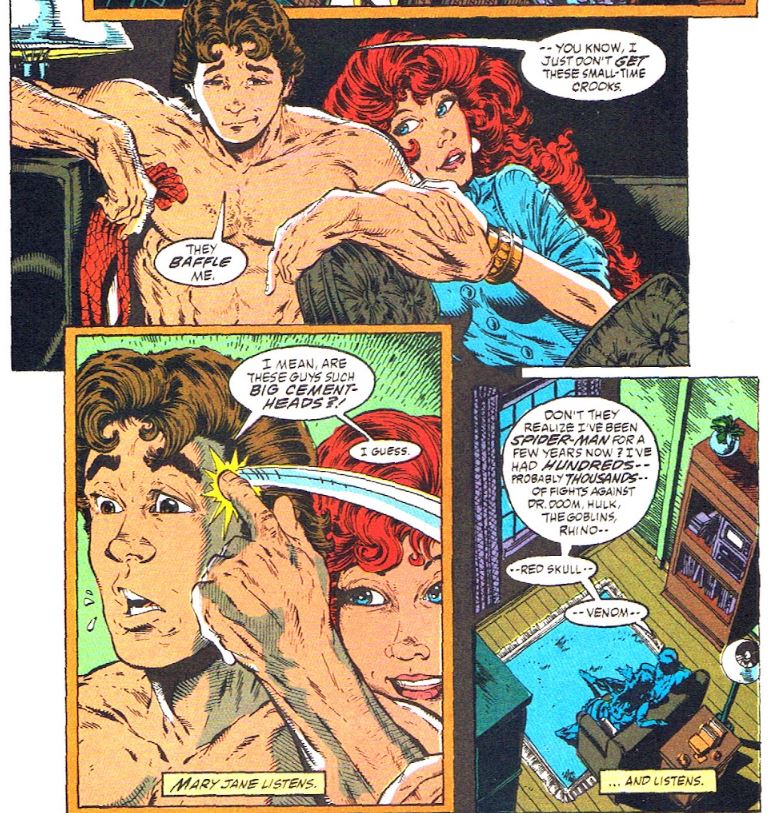
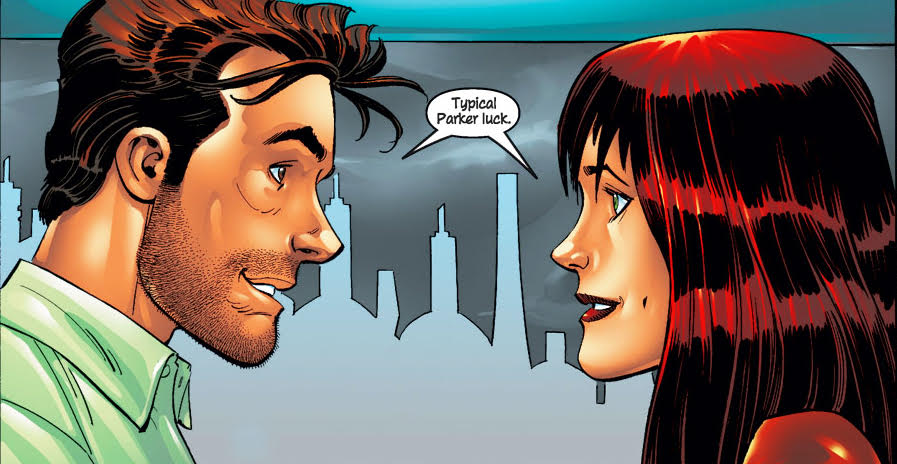

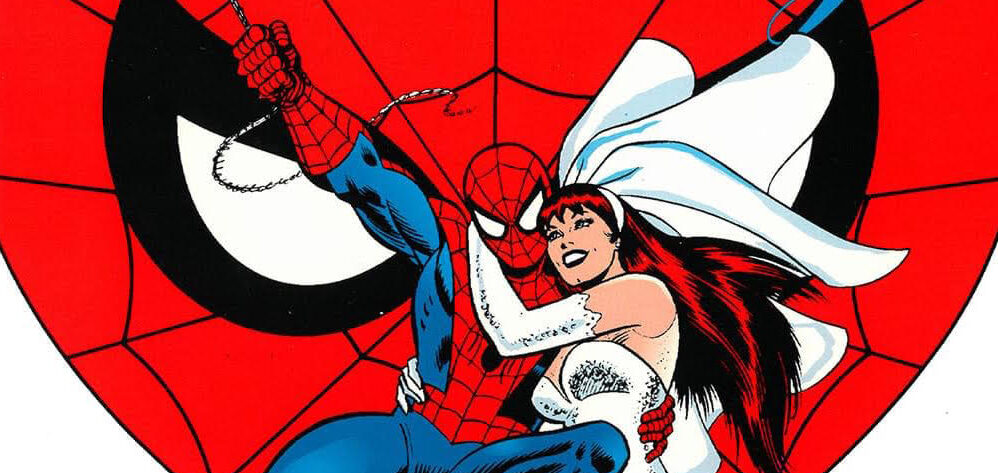
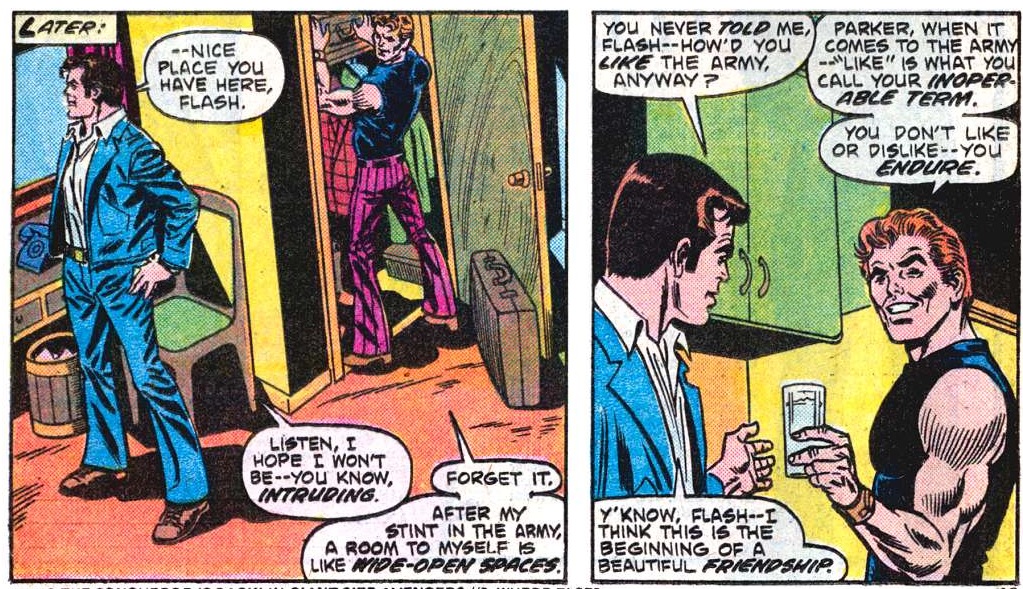
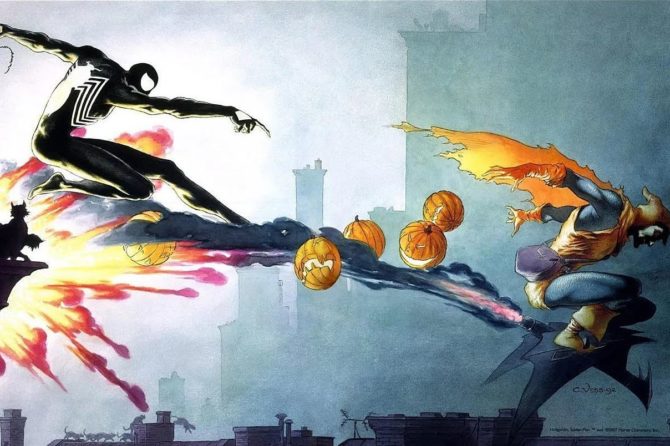






Two comments-of-the-moment:
#1: For the second time since OMD, I’ve put in a book on my pull list. The first was Miracleman (because I just HAVE to read that series now that it’s been revived). The second is the new Ultimate Spider-Man that premieres next week, because I want to support a married Spider-Man. I’m still disgruntled…my vow to resubscribe if they restore the marriage was for the in-continuity Spider-Man books, not for an alternate-reality one, and I still am wishingWISHING they’d come to their freakin’ senses and put it back. But I’m giving this a try, at least.
#2: Has anyone read “The Ones “by Brian Michel Bendis? In the last issue of the first arc, there’s a two-page jab at this old-but-still-offensive OMD garbage. I don’t know how to post screen shots of the pages here…otherwise I would…but I’ll present the dialogue here.
GNOME-TYPE CHARACTER: “Novus, my guy said to keep an eye on your marriage.”
NOVUS (FEMALE SUPER-HERO): Excuse me?
GNOME: Supposedly, Satan has, like, this thing, if shit gets personal, which I guess you made it… He likes to go after people’s marriages. I know you said you like yours.
NOVUS: What?
GNOME: Like if, let’s say, your aunt gets sick. He’ll show up and offer to SAVE YOUR AUNT but in trade he’ll erase your marriage…from reality.
NOVUS: From reality?
GNOME: Well, THIS one. At least. I guess.
NOVUS: Why would he do that?
ANOTHER CHARACTER: It’s true, BTW. I read this.
Just thought I’d share it with ya’ll!
Long standing series like ASM need to evolve over time while keeping the core concept of it. As an example South Park has done it successfully. The tone, topics, everything has evolved. In Spider-Man’s case if they decide single is better at least evolve the stories, make it interesting. But the writers are lazy and rather repeat the same “will they will they not” trope. An easy way to evolve is using what Stan Lee already established at the core origin of the character… growth.
Editors should allow Peter to grow. They should establish that he gets married and then for the next decade of comic books him and MJ are a young married couple.
After the next decade they would be older and more mature.
Next decade they would be allowed to have a baby.
After the next decade the baby can be a kid.
After the next decade the kid can be a teenager.
That right there is 50 years worth of comics. I doubt comics will last that long.
I think the biggest issue is that the last twenty years of comics shows single Peter doesn’t really work. Like they have been trying to establish a love life with the problems that has and what has it accomplished? Does anyone look back at that particular side of the comics and go I really liked when he dated insert whoever? No no one cares at all. Because with his relationship stuff entering an end it all felt pointless and boring.
The problem with relationship drama is it’s easy and allows writers to be lazy. If Peter is in a stable relationship writers can’t go for that low hanging fruit and actually have to try. They have failed at this but I much rather they at the very least be forced to try
Thanks for the replies.
Hornacek- I haven’t really dealt with the marriage is rushed argument because it doesn’t seem relevant. If it’s a status quo that works, it seems foolish to reject because it may have been rushed in the past.
Although now I’m tempted to do an article about the idea that it was rushed. The issue before the proposal hinted that Peter was still involved with the Black Cat. They spent very little time on the engagement. The wedding issue is the same one in which Peter & MJ told Aunt May and Aunt Anna they were getting married. They moved fast.
Sthenurus- I do think it’s not just the clone saga. There have been efforts to take a series back to basics multiple times in different ways, be it a new supporting cast for Peter when he went to grad school, or the jettisoning of the new cast members so Peter could hang out with MJ & Harry Osborn.
With the marriage, there were periods when the status quo didn’t change much. Peter didn’t seem to be in a radically different place at the end of ASM 350 than he was at the beginning of 298.
@Sthenurus
Yes, MJ was always described as gorgeous, but so was Gwen and Peter “got” her long before he and MJ started dating. I feel that by the time Peter and MJ started dating during the Conway run the focus on her being gorgeous had faded away.
@Hornacek
What I meant is that other heroes showed signs of aging (sue and reed having Franklin; Scott and Maddi having a son etc). It’d be weird for Peter, a brilliant student, to be stuck in high school while other heroes have children that clearly show that time is moving forward. I’m not sure I’m super clear on what I mean.
As for MJ she was ALWAYS described has drop dead gorgeous. Even if she became a supermodel later on, she was always “unreachable” for a guy like me… Which made it even better when Peter married her.
@Sthenurus
When Spidey first appears most (all?) of the other Marvel heroes were adults, so they didn’t really age and evolve. Spidey was unique in that he was a teenager and the protagonist – not a sidekick. But unlike the other heroes of the time, he aged in real time. After 3 years of comics he had aged 3 years and graduated high school and gone to university. It was only then that Lee realized that if he kept this up Peter would be as old as the other heroes he often made fun of, so he slowed down his aging when he got to university.
“the idea of the nerd marrying the supermodel was amazing” Didn’t MJ become a supermodel *after* they got married? That’s how it feels to me.
Great read!
One other factor to take into consideration is that Peter’s adventures don’t happen in a vacuum. He is part of a greater universe. You can’t have him staying a high schooler for years, while multiple president are elected, other characters have kids and so on.
I think the marriage to MJ actually made Peter MORE relatable. As a nerdy kid, the idea of the nerd marrying the supermodel was amazing. As an adult, it reflected my own growth.
The main problem with marvel is that ever since the clone saga, characters have become a way to move the plot along and not the other way around. It feels like marvel just decided to freeze everything and character evolution was a sin.
I mean from ASM 1 to 400 you have a complete life story. A teenager growing into a young man, from an high schooler to a undergrad to a grad student; facing grief by seeing his first love die but growing from the tragedy and finding a wife; settling down and expecting a baby; seeing his last parental figure die.
Now compare 400 to 900: aside from the brief period of time during JMS run, what evolution did we get? None. The character went backward somehow. The marriage was erased (when a divorce would have actually added to the life story, not subtracting); he is back to being broke and single. May is back. At now 30 ish year old, Peter is actually moving backward compared to where he was at 20. And that not only doesn’t make sense. It makes him un relatable.
I’d just like to reiterate that the whole “the marriage was rushed” argument is hogwash. People who say this seem to forget that Peter had already proposed to MJ once before – back around ASM #170-ish. Him wanting to marry MJ was not a new development.
Heck, Peter getting married at all goes back to Lee himself. Once Peter and Gwen were seriously dating, he was thinking of marrying her every other issue.
Peter has always been a more mature version of himself, even when he was a teenager in high school. He wore a suit and tie to school, he had a job, he was the sole breadwinner for his household, he had to deal with bills and the mortgage – he was already an adult. So the whole idea of marriage “aging” the character is ridiculous, because the character by his own nature is already “aged” more than his actual chronological age.